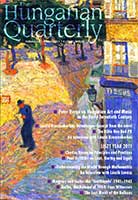
The Hungarian Quarterly
The Hungarian Quarterly
Founded in 1936 by Count István Bethlen (Prime Minister of Hungary 1921–31) The Hungarian Quarterly soon made a name for itself, thanks to contributions from the best Hungarian authors, English and American journalists and politicians who sympathised with post-Trianon Hungary. During the closing stage of the Second World War, fascists killed its editor and the journal ceased publication. The Kádár regime, wishing to improve its image, revived it in 1960 as The New Hungarian Quarterly. The journal reverted to its original name in 1993 after Hungary's return to democracy. Since then The Hungarian Quarterly has been politically neutral seeking to inform and provoke on a wide range of subjects – historians, economists, literary scholars, musicians and film- and theatre-goers will regularly find something stimulating. The journal has earned a peerless reputation for its translations of Hungarian fiction and poetry. Every issue includes poems translated by English and American poets. The Hungarian Quarterly is a resource prized by government agencies, the press, universities and think-tanks. It is listed in numerous bibliographies and indexing services, and can be found in over three hundred major libraries worldwide. Most subscribers are in the U.S., Canada, Britain and Western Europe, but interest extends to countries such as India and Japan too. If readers' letters are anything to go by, the Irish Times reflects the general view when it says The Hungarian Quarterly is "Central Europe's best English-language journal". The Hungarian Quarterly is available by subscription, and is for sale in many of Budapest's bigger hotels and better bookshops. The Hungarian Quarterly appears every March, June, October and December, in B/5 format on 160 pages, with a changing cover in colour, black-and-white illustrations and a colour supplement of 8–16 pages.
More...